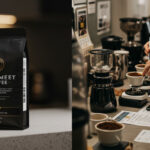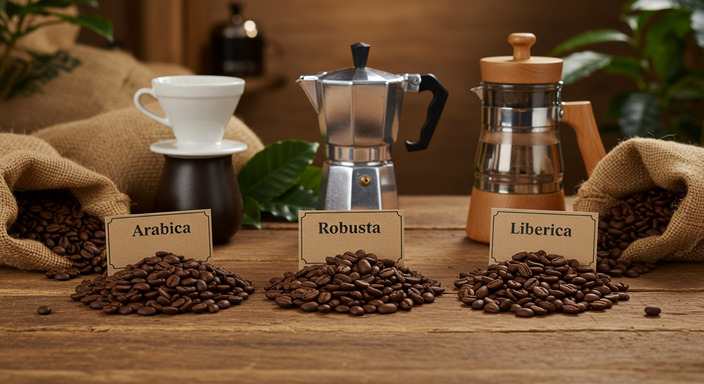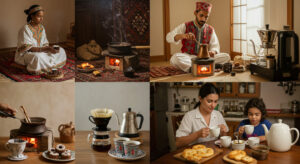
Common Beans Used in Traditional Coffee: A Timeless Brew

Table of Contents
ToggleThe Heart of Traditional Coffee
There’s something profoundly comforting about the aroma of freshly brewed coffee wafting through the air. It’s a scent that transcends time, evoking memories of lazy Sunday mornings, bustling diners, and quiet moments of reflection. Traditional coffee isn’t just a beverage—it’s a ritual, a connection to the past, and a celebration of life’s simple pleasures.
Why Traditional Coffee Remains a Beloved Ritual
For many, coffee is more than a pick-me-up; it’s a cornerstone of daily life. Its role in our routines is deeply rooted in tradition, whether it’s the first sip of a steaming cup to jumpstart the day or the shared pot at a family gathering. Traditional coffee offers a sense of continuity in an ever-changing world, grounding us in familiarity and warmth.
- Cultural Connection: From Italian espresso bars to American diners, coffee has long been a symbol of community, conversation, and connection.
- Timeless Appeal: Unlike trends that come and go, traditional coffee endures, offering a dependable comfort that resonates across generations.
- Personal Ritual: Brewing a cup of coffee can be a mindful act, a moment of pause in an otherwise hectic day.
The Role of Coffee Beans in Creating a Timeless Brew
At the heart of every cup of traditional coffee lies the coffee bean. These small, unassuming seeds hold the power to transform into a drink that has captivated the world for centuries. The type of bean, its origin, and the roasting process all play a crucial role in shaping the flavor, aroma, and essence of the final brew.
| Coffee Bean Type | Flavor Profile | Common Uses |
|---|---|---|
| Arabica | Smooth, slightly sweet, with hints of fruit and floral notes | Drip coffee, espresso, pour-over |
| Robusta | Strong, bold, with a slightly bitter and earthy taste | Espresso blends, instant coffee |
Whether it’s the bright, nuanced flavors of Arabica or the robust intensity of Robusta, the choice of beans can elevate the coffee experience, making each sip a testament to the craft of brewing. It’s this artful combination of tradition and quality that keeps the allure of coffee alive, generation after generation.
Arabica: The Classic Choice
Origins and Cultivation of Arabica Beans
Arabica beans, the heart and soul of traditional coffee, trace their roots to the highlands of Ethiopia, where legend has it that a goat herder first discovered their energizing effects. Thriving at elevations between 2,000 and 6,000 feet, Arabica plants flourish in cool, subtropical climates. Their cultivation requires patience and care, as the delicate plants are susceptible to pests and weather conditions. Today, regions like Latin America, East Africa, and parts of Asia have become global hubs for Arabica production, preserving the bean’s rich agricultural heritage.
Flavor Profile: Smooth, Sweet, and Aromatic
Arabica beans are celebrated for their elegant and nuanced flavor, a hallmark of classic coffee. When brewed, they offer a symphony of notes—gentle hints of chocolate, caramel, and fruit, underscored by a naturally sweet finish. The aroma is equally enchanting, often described as floral or berry-like, evoking a sense of comfort and warmth. This smooth and balanced profile makes Arabica a favorite for those who savor coffee as a daily ritual rather than just a caffeine fix.
Why Arabica is a Staple in Traditional Coffee
Arabica’s enduring popularity lies in its ability to embody the essence of coffee tradition. From the cozy diners of the American Midwest to the bustling cafés of Europe, Arabica has become synonymous with quality and reliability. Its versatility shines in brewing methods like drip coffee, French press, and pour-over, making it adaptable to personal tastes and cultural preferences. Arabica’s timeless appeal connects generations, whether it’s the robust brew that kickstarts the morning or the comforting cup shared with loved ones.
Robusta: Bold and Resilient
A Legacy of Strength and Resilience
Robusta beans, scientifically known as Coffea canephora, have a history as robust as their flavor. Originating in sub-Saharan Africa, these hardy beans quickly gained recognition for their ability to thrive in challenging climates and resist disease. Unlike their more delicate counterpart, Arabica, Robusta plants grow at lower altitudes and produce higher yields. This resilience made them a staple in coffee cultures worldwide, particularly in regions where conditions are less forgiving. Their journey from African forests to global prominence is a testament to their enduring strength and versatility.
Flavor Profile: Strong, Earthy, and Slightly Bitter
Robusta beans are celebrated for their bold, unapologetic flavor. With nearly twice the caffeine content of Arabica, they deliver a powerful punch that awakens the senses. The flavor profile is often described as strong, earthy, and slightly bitter, with notes of dark chocolate, nuts, and even a touch of smokiness. While some may find its intensity overwhelming on its own, this robust character is what makes it indispensable in traditional coffee blends. It’s the kind of flavor that lingers on your palate, a reminder of coffee’s deep, grounding roots.
Adding Depth to Traditional Blends
In traditional coffee blends, Robusta plays a vital role, adding depth and complexity that elevate the overall experience. Its boldness complements the smoother, more nuanced flavors of Arabica, creating a balanced and memorable cup. For many, it’s the secret ingredient in classic espresso blends, providing that rich crema and full-bodied texture that coffee lovers crave. Whether it’s a strong morning brew or a comforting after-dinner espresso, Robusta’s presence is felt—a reminder of the simple, enduring pleasures of coffee.
Liberica: The Rare Gem
The Unique Story of Liberica Beans
In the vast world of coffee, Liberica stands as a rare and treasured gem. Originating from the forests of western and central Africa, these beans made their way to Southeast Asia in the late 19th century, where they flourished in countries like the Philippines and Malaysia. Unlike their more common counterparts, Arabica and Robusta, Liberica beans have a distinct, irregular shape and a bold, almost whimsical presence. Their rarity stems from their finicky cultivation requirements, making them a prized find for coffee enthusiasts who seek the extraordinary. This storied bean carries with it a legacy of resilience and adaptability, having survived the great coffee rust epidemic that devastated other varieties in the 19th century.
Flavor Profile: Smoky, Floral, and Fruity
Liberica beans are celebrated for their uniquely complex flavor profile, a delightful departure from the familiar. Imagine a sip that begins with a smoky, almost woody undertone, slowly unfolding into subtle floral notes reminiscent of jasmine or honey. The finish is where the magic happens, leaving behind a hint of fruity sweetness that lingers on the palate, like ripe tropical fruits or even a touch of jackfruit. This intricate balance of flavors makes Liberica a coffee that demands attention and appreciation, perfect for those who crave a cup that tells a story with every sip.
Its Niche Role in Traditional Coffee Traditions
While Liberica may not dominate the global coffee market, it holds a special place in the hearts of those who cherish traditional coffee traditions. In the Philippines, for example, Barako—a local variety of Liberica—is a cultural icon, often served in rural homes and small-town cafes. Its bold, earthy aroma and robust flavor evoke a sense of nostalgia, harkening back to simpler times when coffee was more than just a beverage; it was a ritual, a way of life. For many, Liberica represents a connection to heritage, a reminder of the enduring beauty of coffee’s cultural roots. Whether enjoyed in a quiet morning moment or shared among friends, Liberica continues to carve out its niche, one cup at a time.
Excelsa: The Underappreciated Bean
Origins and Traits of Excelsa Beans
Excelsa, often overshadowed by its more famous coffee relatives, hails from the lush landscapes of Southeast Asia. Though technically a member of the Liberica family, its unique characteristics set it apart. Grown primarily in countries like the Philippines and Vietnam, Excelsa thrives at higher altitudes, where its beans develop a distinctive profile that coffee aficionados have come to cherish. Its rarity and unconventional flavor have made it a hidden gem in the world of traditional coffee.
Flavor Profile: Tart, Complex, and Wine-Like
What makes Excelsa truly special is its tart and complex flavor. Unlike the bold bitterness of Robusta or the smooth sweetness of Arabica, Excelsa offers a wine-like acidity that dances on the palate. Notes of dark fruit, a hint of smokiness, and an earthy undertone create a layered experience that is both intriguing and satisfying. It’s a bean that invites you to slow down and savor every sip, making it a perfect candidate for those who appreciate the artistry of coffee.
Contribution to Traditional Coffee Blends
While Excelsa is a standout on its own, its true magic often lies in its ability to enhance traditional coffee blends. Its tartness and complexity add depth and dimension, balancing out the smoother, more familiar flavors of Arabica and Robusta. In many cultures, Excelsa is blended to create a cup that is richer, more aromatic, and subtly adventurous. Whether it’s a morning brew or an after-dinner treat, Excelsa brings a touch of the extraordinary to the everyday coffee experience.
Brewing Methods That Honor Tradition
How Different Beans Shine in Classic Brewing Techniques
The art of brewing coffee is as much about the beans as it is about the method. Arabica beans, with their smooth, nuanced flavors, excel in pour-over methods like the Chemex or V60. Their delicate notes of fruit, chocolate, or floral undertones are gently coaxed out by the slow, steady drip of water. On the other hand, the bold, robust character of Robusta beans makes them a perfect match for traditional espresso machines. Their high caffeine content and earthy, nutty flavors create a rich, intense shot that forms the backbone of classic cappuccinos and lattes.
For those who cherish the nostalgia of a stovetop percolator or a French press, Sumatra beans are a delightful choice. Their full-bodied, earthy profile is enhanced by the immersion brewing process, resulting in a cup that feels like a warm embrace. Meanwhile, Ethiopian beans, with their bright acidity and complex fruity notes, sing in a siphon brewer, where the theatrical process highlights their vibrant personality.
Tips for Selecting the Right Bean for Your Preferred Method
Choosing the perfect bean for your favorite brewing technique is a journey of discovery. Here are a few tips to guide you:
- For drip coffee lovers: Opt for medium-roast Arabica beans to bring out balanced flavors and a smooth finish.
- For espresso enthusiasts: Look for darker roasts, such as a Brazilian or Italian blend, to achieve that rich, caramelized depth.
- For French press aficionados: Embrace beans with bold, earthy profiles like Sumatran or Sulawesi, which thrive in this method.
- For pour-over purists: Experiment with single-origin beans, like Ethiopian or Colombian, to uncover their unique terroir.
Remember, the grind size is just as crucial as the bean itself. A coarse grind suits the French press, while a fine grind is essential for espresso. Matching the grind to your brewing method ensures the flavors are extracted perfectly, honoring the legacy of traditional coffee-making.
Celebrating Coffee’s Cultural Roots
Traditional coffee beans are more than just a morning pick-me-up; they are a bridge to our past, connecting us to centuries of history and heritage. Each sip of a classic brew carries the whispers of generations who have cultivated, roasted, and shared this beloved beverage. Coffee is not just a drink—it’s a story, a ritual, and a legacy.
A Journey Through History
The origins of coffee date back to ancient Ethiopia, where legend says a goat herder first discovered the energizing effects of coffee cherries. From there, coffee spread across the Arabian Peninsula, Europe, and eventually the Americas, evolving with each culture it touched. Today, the beans we grind and brew are a testament to this rich, global journey. Traditional varieties like Arabica and Robusta carry the essence of their origins, offering a taste of the lands where they were first cultivated.
Consider these milestones in coffee’s history:
- The Ottoman Empire: Coffeehouses became cultural hubs for conversation and creativity.
- Colonial America: Coffee replaced tea as the drink of choice after the Boston Tea Party.
- 20th Century: Diner-style drip coffee became a staple of American life.
Coffee in Family and Community Traditions
Across the globe, coffee has always been a unifying force, bringing people together in moments of joy, reflection, and connection. In many families, the ritual of brewing and sharing coffee is a cherished tradition passed down through generations. Whether it’s a grandmother’s secret recipe for the perfect cup or the simple act of gathering around the kitchen table, coffee fosters a sense of belonging.
In communities, coffee plays an equally vital role. From the bustling cafes of Italy to the humble coffee carts of small-town America, these spaces serve as meeting points where stories are shared and friendships are nurtured. Traditional coffee ceremonies, like those in Ethiopia or Turkey, highlight the cultural significance of this beverage, turning the act of drinking coffee into a celebration of life itself.
FAQs About Coffee’s Cultural Roots
Why are traditional coffee beans significant? Traditional beans, like Arabica and Robusta, carry the history and flavors of their native regions, offering a connection to the cultures that first cultivated them. How has coffee shaped family traditions? From morning rituals to holiday gatherings, coffee often serves as a centerpiece for family bonding and shared memories. What are some famous coffee ceremonies around the world? Ethiopia’s coffee ceremony and Turkey’s intricate brewing rituals are two examples of how coffee is celebrated as a cultural cornerstone.
As we savor our daily cup, let us remember that coffee is more than a beverage—it’s a celebration of humanity’s shared history and a reminder of the moments that bring us together. In every brew, we honor the traditions, the stories, and the people who have made coffee a timeless part of our lives.
is a writer and editor at Coffee With Finance, blending her love for coffee, personal finance, and visual storytelling. She crafts engaging articles, curates site images, and shares brewing tips, bean origins, and practical money advice. Anna believes that managing finances, like making great coffee, should be intentional and rewarding — bringing clarity, warmth, and beauty to every story she tells.




























Post Comment